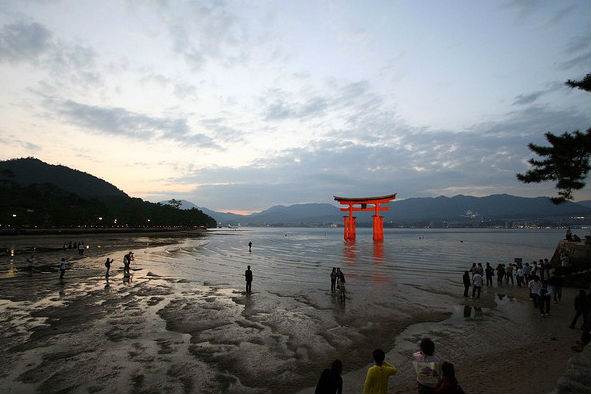In a country where the capital possesses a permanent neon blink and technology dangles at the end of every spare hand, taking the ferry out to Japan’s small island of Miyajima feels like a journey back in time.

The Itsukushima Shrine, on the waterfront of Miyajima. (Photo: exilism via Flickr)
Located less than an hour off the coast of Hiroshima in the Island Sea of Japan, Miyajima, (meaning ‘shrine island’ – the island’s formal name is Itsukushima), has been a location of religious significance since 809 A.D. when Kōbō Daishi, a Buddhist monk, visited the island.
Today, the pace of progress has been slow and the scenery seems the better for it with Edo period streets prevailing over development and herds of deer roaming free. Cars are rare and traffic lights simply not necessary, making a visit to the island the perfect antidote to the big cities that define much of Japan.
Miyajima’s Itsukushima Shrine
The Itsukushima Shrine with its red and black lacquered maze of rooms and pathways is a vast space on the island’s waterfront and acts as a key attraction for visitors. The shrine is a UNESCO World Heritage Site and clearly deserves the accolade, but it is the shrine’s similarly red and black lacquered torii gate that steals the show. Built away from the shrine, out in the middle of the island’s coastal sand, this structure is not only a sight that can leave you eyes wide, it offers a visual performance with views that vary dramatically according to the ebb and flow of the tide.
Visit when the tide is out and you can squelch over the damp, sticky sand to stare straight up at its magnificence. Touch the torii gate, inspect the limpets clinging to its lower legs and stand impressed at its robustness. Yet, it is when the water rises high that the true magic of Miyajima is revealed. Inch by inch as the surrounding sea creeps up the base of the gate and the structure becomes partially submerged, the torii takes on an ethereal state, as it appears to float right out of the water. Add a sunset with the day’s glow slowly retreating over the horizon, and it’s hard to imagine a more beautiful sight.
Mt Missen And The 1,200 Year Old Flame
Yet, the shrine and gate are not the only reasons to visit Miyajima. The island is home to a substantive mountain, Mt. Misen, which sits 535 metres above sea level, and is the place where Kōbō Daishi went to pray when he first visited the island. Almost hidden amongst the weaving routes near the summit of the mountain lies the spot, now marked with a temple, where, in 809 A.D. this famous Buddhist monk lit a flame and meditated for 100 days.
As staggering as it is to comprehend, the same flame can be seen today. Thanks to a succession of monks who have tended to the fire, Kōbō Daishi’s original flame has continued to burn for over 1,200 years. Enter the tranquillity of the temple complex and the flame is quick to find, detectable by the constant plume of smoke that spews into the air in testament to the fire’s longevity and on-going existence.
Mt. Misen makes for a glorious hike across wooden bridges, over ponds and slowly up through the undergrowth to the top. But there is an equally picturesque alternative ascent via the ropeway (cable car) that presents incredible vistas of the small islands jutting out of the surrounding sea. If you previously wondered about the naming of this location as the Island Sea, the panoramas at the top of Mt Misen will solve the problem.
Back at sea level, the five-storied Goju-no-to pagoda, dating back to 1407, completes the scene of traditional Japan with its vivid red structure piercing the skyline.
After a long day of exploring the many splendours of Miyajima, it pays to linger after the last ferry heads back to the mainland. The fact that the island is home to the world’s largest rice spatula, which stretches over 5 metres in length and is proudly set out on display, is an indicator of the island’s culinary talents. Although there isn’t a vast selection of restaurants that stay open late into the night, the ones that do offer up some of the island’s finest food.
When in season, one of Miyajima’s best edible delights is the oysters and if you saunter past the beach front near low-tide, you will most certainly witness the island’s oyster pickers digging deep into the sand in a frenzy to work out the prizes that the sea has left behind. Throughout Miyajima, the barbecues burn brightly and the oysters could barely be fresher as they travel a matter of metres from waterfront to grill to plate.
There may not be single flash of neon on Miyajima but the burning barbecues, the 1,200 year old flame atop Mt. Misen and the floating torii gate provide all the sparkle this island needs.